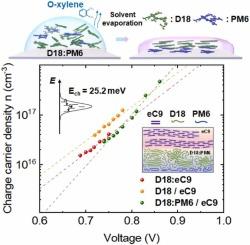利用施主取向工程抑制非卤化有机太阳能电池的陷阱态
IF 17.1
1区 材料科学
Q1 CHEMISTRY, PHYSICAL
引用次数: 0
摘要
本研究利用pm6 - D18供体系统的分层(LbL)结构,研究了由非卤化溶剂加工的有机太阳能电池(OSCs)中减少重组诱导电压损失的来源。瞬态光电压和光电流测量以及掠入射广角x射线散射分析表明,PM6促进了D18给体层内有利的面朝分子取向并增强了结构秩序化。这种改进的有序性通过尾态局域能量无序有效地减轻了载流子捕获,从而加强了双分子重组并导致了显著的电压损失。此外,pm6诱导的D18分子排列调节了上覆eC9受体层的形态,导致陷阱态密度进一步降低。瞬态吸收光谱验证了陷阱态能级的降低限制了载流子复合,延长了载流子寿命,从而提高了光伏性能。这些发现确定供体分子取向是控制LbL osc能量紊乱的关键形态学参数。总的来说,所提出的战略为克服使用无害环境的非卤化溶剂加工OSCs的局限性提供了一条可行的途径。本文章由计算机程序翻译,如有差异,请以英文原文为准。

Suppressing Trap States via Donor Orientation Engineering in Non-Halogenated Layer-by-Layer Organic Solar Cells
This study investigates the origin of reduced-recombination-induced voltage loss in organic solar cells (OSCs) processed from non-halogenated solvents using a layer-by-layer (LbL) architecture with a PM6-incorporated D18 donor system. Transient photovoltage and photocurrent measurements, along with grazing incidence wide-angle X-ray scattering analysis, reveal that PM6 promotes a favorable face-on molecular orientation and enhances structural ordering within the D18 donor layer. This improved ordering effectively mitigates carrier trapping through tail-state-localized energetic disorder, which intensifies bimolecular recombination and contributes to notable voltage losses. Moreover, the PM6-induced molecular alignment of D18 modulates the morphology of the overlying eC9 acceptor layer, leading to a further reduction in trap state density. Transient absorption spectroscopy verifies that the reduction in trap-state energy levels limits charge carrier recombination and prolongs carrier lifetimes, thereby improving photovoltaic performance. These findings identify donor molecular orientation as a critical morphological parameter governing energetic disorder in LbL OSCs. Overall, the proposed strategy offers a viable route for overcoming the limitations of OSCs processed using environmentally benign non-halogenated solvents.
求助全文
通过发布文献求助,成功后即可免费获取论文全文。
去求助
来源期刊

Nano Energy
CHEMISTRY, PHYSICAL-NANOSCIENCE & NANOTECHNOLOGY
CiteScore
30.30
自引率
7.40%
发文量
1207
审稿时长
23 days
期刊介绍:
Nano Energy is a multidisciplinary, rapid-publication forum of original peer-reviewed contributions on the science and engineering of nanomaterials and nanodevices used in all forms of energy harvesting, conversion, storage, utilization and policy. Through its mixture of articles, reviews, communications, research news, and information on key developments, Nano Energy provides a comprehensive coverage of this exciting and dynamic field which joins nanoscience and nanotechnology with energy science. The journal is relevant to all those who are interested in nanomaterials solutions to the energy problem.
Nano Energy publishes original experimental and theoretical research on all aspects of energy-related research which utilizes nanomaterials and nanotechnology. Manuscripts of four types are considered: review articles which inform readers of the latest research and advances in energy science; rapid communications which feature exciting research breakthroughs in the field; full-length articles which report comprehensive research developments; and news and opinions which comment on topical issues or express views on the developments in related fields.
 求助内容:
求助内容: 应助结果提醒方式:
应助结果提醒方式:


